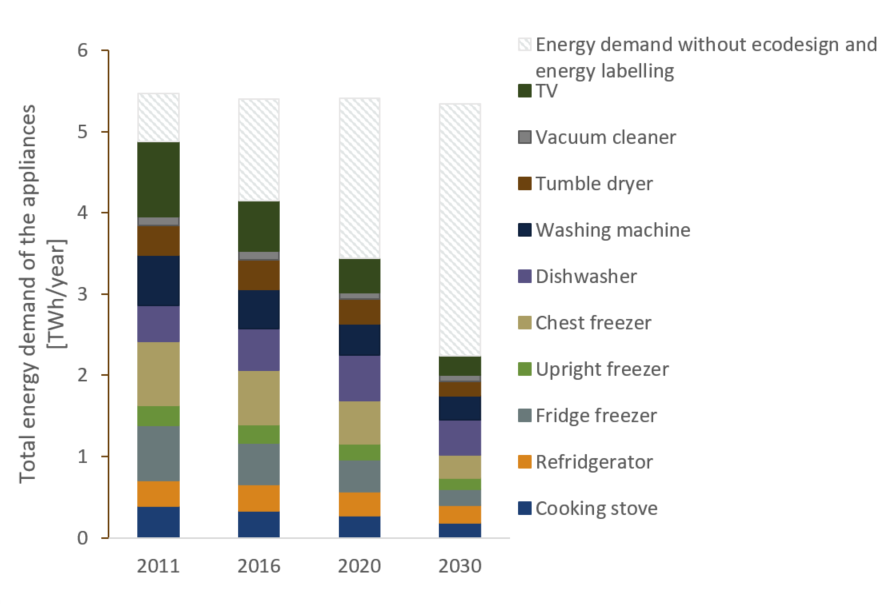Ecodesign and Energy Labelling directives cause 3 TWh energy savings in Norwegian household appliances in 2030
The Norwegian Water Resources and Energy Directorate (NVE) has analysed the impact of Ecodesign and Energy Labelling of products on the total energy consumption of 10 common household appliances in Norway which account for about 10 % of the total household energy consumption in Norway. These appliances are refrigerators, fridge freezers, and upright freezers, chest freezers, cooking stoves, washing machines, dishwashers, tumble dryers, vacuum cleaners and TVs.
The Ecodesign Directive requires that energy-related products fulfil Ecodesign minimum levels of energy efficiency and environmental performance. The Energy Labelling Directive imposes mandatory labelling and information requirements that indicate the consumption of energy and other resources by energy-related products, with the purpose of guiding the consumer in choosing the most energy efficient product options on the market. The first Ecodesign and Energy Labelling requirements entered into force in Norway in 1996 (for refrigerators, freezers, washing machines and some other appliances) and has since been revised and come to include more product groups.
The number of appliances increase while the electricity demand for appliances decrease
It is estimated that the total energy use of the Norwegian stock of these household appliances was about 5 TWh in 2011. Between 2011 and 2016 there was an increase in both the total number of households and appliances per household in Norway. Still, it is estimated that the total energy use of the household appliances dropped to 4 TWh from 2011 to 2016 due to the appliance stock becoming more energy efficient. It is expected that the number of households and household appliances will continue to grow in the years to come, but that the total energy consumption of the product groups will drop to 2 TWh in 2030. This is because new appliances are significantly more energy efficient than old appliances, so even though the total number of appliances increase, the replacement of older appliances contributes to reduce the total energy use. Norwegian households replace old appliances frequently, the average age of most types of household appliances is less than ten years, and more than half of our TVs are under five years. This means that the appliances used in Norwegian households are relatively new and thus also energy efficient.
It is assumed that household appliances would become somewhat more energy efficient towards 2030 in a scenario without the Ecodesign and Energy Labelling directives (based on a similar study conducted for the European Commission (2)). However, the appliances would not become as efficient in 2030 in a scenario without the directives as they are expected to become with the development we see today. Due to this, it is estimated that the total energy use of the household appliances analysed in this report would need 3 TWh more electricity in 2030 in a scenario without the Ecodesign and Energy Labelling directives, compared to the expected energy use in the scenario with the directives. This is shown in the diagram below.

About the study
The analysis conducted in this report is mainly based on two large surveys, statistics of household appliances sold in Norway and a similar study conducted for the European Commission (2). Several assumptions and simplifications have been made in the analysis, and hence there are uncertainty connected to the results. More efficient electrical appliances results in less waste heat from the appliances, which may cause the need for energy for space heating to increase slightly in parts of the year. The study does not take into account the effect of the directives on other product groups, the increase in use of products, which are not included in the directives, or the energy use of products in standby mode. Despite the uncertainty in the results, we conclude that the Energy Labelling and Ecodesign requirements for products will significantly reduce the use of electricity in electrical appliances in Norwegian households. The uncertainty is related to the magnitude of the total reduction in energy use in 2030.
